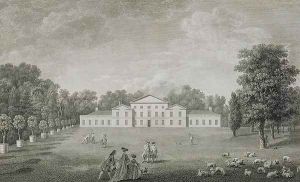Kirby, John Joshua Paintings
John Joshua Kirby was an English landscape painter, engraver, and writer, born in Parham, Suffolk in 1716. He is best known for his work as a topographical draughtsman, which led to his election as a Fellow of the Society of Antiquaries and a member of the Society of Artists. Kirby's most significant contribution to the world of art was his theoretical work on perspective, which had substantial influence during his time.
Kirby's father was a schoolmaster, and this background in education likely influenced his approach to art and his interest in the theoretical aspects of perspective. He initially started his career as a house painter in Ipswich, but his talent for drawing architectural subjects was quickly recognized. In 1748, Kirby published 'Twelve Prints and a Map of the Most Remarkable Places in Suffolk,' which gained him considerable attention. His accurate and detailed renderings of buildings and ruins showcased his mastery of perspective.
In 1754, Kirby published his most notable work, 'Dr. Brook Taylor's Method of Perspective Made Easy, Both in Theory and Practice.' In this two-volume treatise, he simplified the work of mathematician Brook Taylor, making the principles of linear perspective accessible to artists and architects. Kirby's book was influential and went through several editions, securing his reputation as an authority on the subject.
Kirby's connections and reputation grew as he became drawing master to George III before his accession, and in 1761 he was appointed Clerk of the Works at Kew Gardens. His position in the royal household underscored his status in the art world. Kirby continued to teach perspective and had several notable pupils, including Thomas Gainsborough, who held Kirby in high regard.
Throughout his career, Kirby contributed to the documentation of historical and architectural subjects through his engravings and drawings. His works were appreciated for their accuracy and aesthetic quality and formed an important record of English heritage sites during the 18th century.
John Joshua Kirby passed away in 1774, leaving behind a legacy as an educator, artist, and author who bridged the gap between the theoretical rigors of perspective and practical application in the visual arts. His teachings and writings on perspective would influence British artists well into the 19th century, reflecting the enduring impact of his scholarly approach to art.
